Меню
Social networks
Sections
Oct. 30, 2023, 10:32 p.m.
Destruction of grain as a weapon: journalists identified the Russians involved
Цей матеріал також доступний українською410
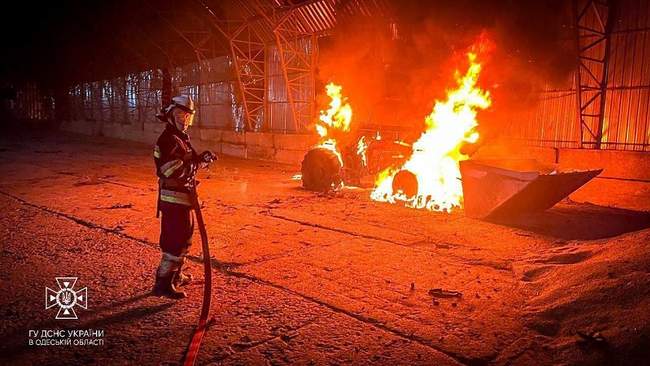
Photo credit: State Emergency Service, SES
90 years ago, invaders from the East brought to our land not only war and repression but also artificial famine. For the reluctance of peasants to join collective farms, Soviet executioners punished Ukrainians with a famine that took millions of lives. Dozens of years later, history repeats itself: yet again, the invader's descendants come to our land again and take away our grain.
When Russia announced its withdrawal from the Grain Deal, which had been in effect for a year at the time, the Odesa region found itself under massive missile and kamikaze drone attacks. After all, Ukrainian grain was exported to the world through Odesa port despite the full-scale war. Before that, the grain deal facilitated the export of Ukrainian agricultural products by sea during the full-scale war.
Center of Public Investigations was looking into persons who might be involved in the shelling of the Odesa region and the destruction of Ukrainian grain.
Grain blackmail
In addition to the bombing of agricultural enterprises and port infrastructure, grain stores and silos suffer regular Russian strikes. Hundreds of thousands of tons of grain have already been destroyed. In this way, the Kremlin is trying to blackmail Ukraine and the whole world.
 Photo: Operational Command "South"
Photo: Operational Command "South"
"The grain deal expired on July 17. And since July 18, Odesa infrastructure – grain silos, terminals, port infrastructure, even moving grain trucks – has been actively attacked by missiles," said Alla Stoianova, the director of the Department of Agrarian Policy, Food and Land Relations of Odesa Military Administration.
We discussed this comment with Oleksandr, a farmer from the south of Odesa region, and he confirmed her words. He says he knows the agricultural enterprises that suffered from Russian attacks this summer. Russian kamikaze drones also hit the oil depot: "Thanks to our guys, not all of them /drones/ made it. Once, our friend from the Vilkove territorial community took down a drone with a hunting weapon. We are all very grateful to him."
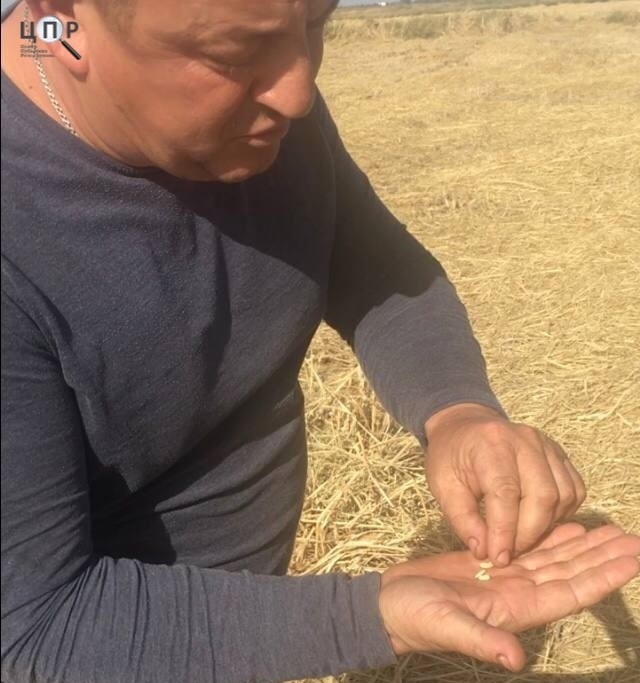 Farmer Oleksandr. Photo credit: CPI
Farmer Oleksandr. Photo credit: CPI
According to Alla Stoianova, 21 agricultural enterprises were destroyed only in the Odesa region, costing millions of lost incomes. The agrarians provide the economy with the lion's share of foreign currency earnings. Russia's war against Ukraine and, as a result, disruptions in the supply chain of our agricultural products may result in famine in poor countries. According to last year's data, 47 million people are at risk: "The latest indicators are very negative. For example, in 2018, approximately forty-six countries were on the brink of starvation. In 2022, already 70 countries face the same risk. This is a significant indicator demonstrating that Ukraine should export (grain – ed.) in time."
Growing wheat is like raising a child
It is especially painful for farmers to watch the destruction of wheat. After all, it takes so much effort to grow it. Oleksandr, a farmer, has been engaged in agriculture for three years. He explains that agricultural business is risky by default. And amidst the war, the risks increase dramatically: "It’s like a baby. You have to sow it and grow it, invest in it. Much depends on weather conditions. If there is no rain, you get neither grain nor sunflowers. Now, the price has dropped a lot for both wheat and barley. No rain means no harvest. During the war, the prices of both wheat and corn are very low. Thank God we are alive and well. The guys do their job. We are grateful to our defenders. We have three employees; three mechanics have joined the Army. One is missing in action."
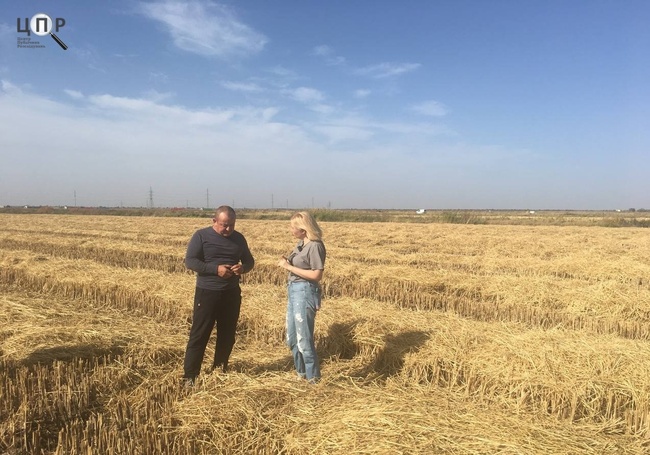 Photo credit: CPI
Photo credit: CPI
Russians claim there is weapons concealed in grain
Meanwhile, the RF representatives traditionally claim they destroy not grain but Ukrainian military equipment. This statement was made at the UN meeting by Vasyliy Nebenzia, the representative of the Russian Federation: "I’m emphasising again that Russia does not strike at civilian objects and does not aim at civilians. Our high-precision weapons are used exclusively to destroy the military potential of the Zelensky regime and the facilities associated with it. If Ukraine uses granaries and port infrastructure to store ammunition and Western equipment, then they will also be destroyed."
However, the founder of the agricultural enterprise, Oleksandr, categorically rejects this statement: "It's a lie. You understand they are lying. They never tell the truth. How is it possible to hide weapons in a silo, in grain? God forbid something activates a grenade /you hid there/ - you become the enemy to yourself. Well, let them talk, and we have to work."
Ukrainian law enforcement officers investigate the attacks
As the Odesa Regional Prosecutor's Office informed CPI, since the Russian Federation withdrew from the grain deal, law enforcement officers have been investigating 16 criminal proceedings related to the aggressor country's shelling of grain warehouses in the region. All are classified under the article of violation of the laws and customs of war. The Prosecutor's Office did not say whether anyone was indicted for these investigations.
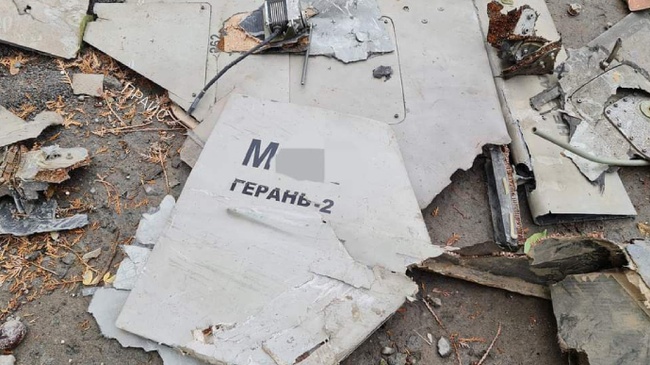 Destroyed "Shahed". Photo from the network
Destroyed "Shahed". Photo from the network
Compared to last year, the Russian Federation has significantly increased attacks on Ukraine by the so-called Shahed kamikaze drones of Iranian origin.
Oleh Katkov, editor-in-chief of Defense Express, which specialises in military-technical production, explains that Shahed drones 136/131 are classified as kamikaze drones. However, it is correct to call them aircraft projectiles because they are launched at known stationary targets: "They are used en masse. If we take the September (2023 - ed.) indicator, it is more than half a thousand launched Shaheds. The Air Force of Ukraine reports that about 80% of them have been taken down. But if half a thousand of them attack us every month, it means a fairly significant part breaks through."
Russia plans to establish and increase the "Shahed" production
Shahed drones are produced in Iran and transported to the Russian Federation by air or sea. There, the "Geran" marking hides the weapon's foreign origin.
In February, the Institute for the Study of War reported on the possible direct participation of Iranian military personnel in the Russian Federation's attacks on Ukraine. With reference to Ukrainian intelligence data, the analysts studied the audio recording of the conversation between two Shahed drone operators. They spoke a "Kurdish dialect interspersed with Farsi words."
The drone’s warhead weighs up to 50 kilograms and can fly at a speed of 200 kilometers per hour. Currently, Russia cannot provide for the entire production cycle of Shaheds, but the Russian military is working in this direction.
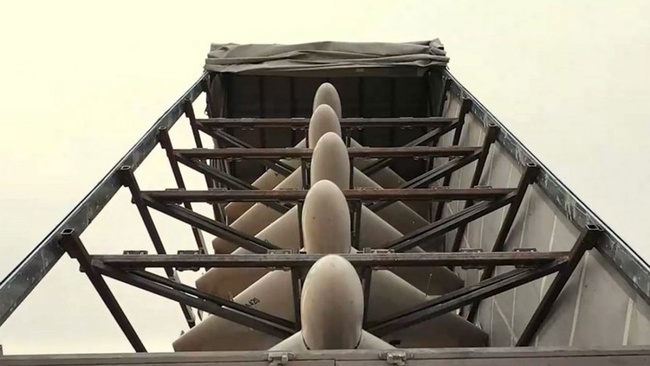 "Shahed"/"Geran". Photo from the network
"Shahed"/"Geran". Photo from the network
" We all know they plan their localised production in the exclusive industrial economic zone of Alabuga in Tatarstan, near Naberezhnye Chelny. But this project is only unfolding. According to the estimates of the Russian opposition journalists, we are talking about a multi-year project that will cost several billion dollars," Oleg Katkov said.
In August, The Washington Post published an investigation into the deployment of UAV production in Tatarstan. By the summer of 2025, Russia plans to produce six thousand Shahed kamikaze drones at its facilities. However, there are also known difficulties with this project's implementation, particularly associated with critical dependence on smuggling Western electronics supplies.
Molfar community has identified some employees who are involved in the production of "Shahed" in Alabuga. Among them are representatives of the Russian special services and the Ministry of Defense.
Currently, analysts outline certain modifications of the Iranian "Shahed" technologies, which may indicate close cooperation between Iranian and Russian specialists. We also know about increasing production volumes.
"The so-called new Shahed-136 (or Geran-2, as it is called in the Russian Federation) does not fundamentally differ from earlier models. Their tactical and technical characteristics are identical. The described differences are cosmetic and aimed at achieving a banal goal: reducing this loitering munition’s production cost. The replacement of Shahed-136 or Geran-2 parts also proves the effectiveness of foreign sanctions and Russia's desire to unify the production of unmanned aerial vehicles and other so-called high-tech production," reported Andriy Rudyk, a representative of the Centre for Research of Trophy and Advanced Weapons and Military Equipment, during a recent briefing.
An effective means of defeat
For the enemy, Shaheds became an effective means of striking targets. First of all, it is due to their low cost, and the Russian military industry is trying to make production even cheaper.
The estimated cost of a Shahed is 20-40 thousand dollars. For the Russian Federation, they can cost up to 100,000 dollars. For comparison, a cruise missile costs about a million dollars. It means 50 cruise missiles cost as much as 500 Shaheds.
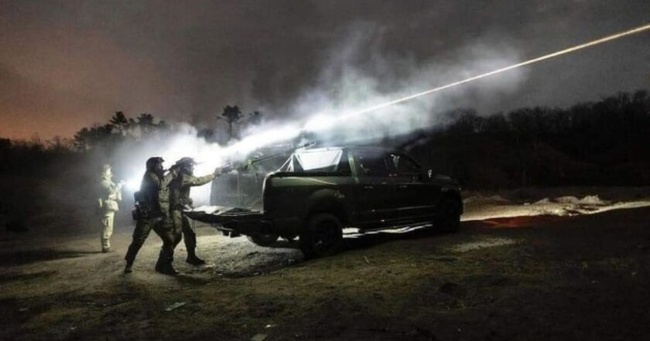 Shooting down Shaheds. Photo from the network
Shooting down Shaheds. Photo from the network
But Shahed drones have another advantage: they are difficult to detect by air defence. The expert Oleg Katkov emphasises that a Shahed is, in fact, a small, low-altitude target, so it is difficult to detect: "The main way of how these targets break through such is to bypass air defence means. That is, not to fly over them, but to bypass their area making manoeuvres."
Who can be involved in the launch of "Shahed"?
Airfield in Primorsko-Akhtarsk
According to the "Monitor" community, to attack in the South of Ukraine, in particular the Odesa region, Russia launches Shaheds from two sites – Primorsko-Akhtarsk in the Krasnodar Krai and Cape Chauda in the Crimea.
In May 2023, a Shahed , which did not reach Ukraine, was retrieved from the Sea of Azov in Primorsko-Akhtarsk. It yet again proves that this place is used by the Russian military to attack our cities.
According to open sources, the 960th Guards Assault Aviation Regiment of Military Unit 75387 is stationed in Primorsko-Akhtarsk. The regiment took part in military operations in Georgia in 2008 and in Syria since 2015. In addition to the Shaheds launches, the Primorsko-Akhtarsk stationed personnel bombed Ukrainian cities, including Mariupol, during the full-scale invasion. The military unit commander is Colonel Sergii Atroshchenko, born in 1981.
According to the website Myrotvorets, Atroshchenko was born in the Zhytomyr region but serves in the Russian army. Ukrainian activists from Cyber Resistance hacked Atroshchenko's email and received information about this war criminal, his lifestyle, and his subordinates.
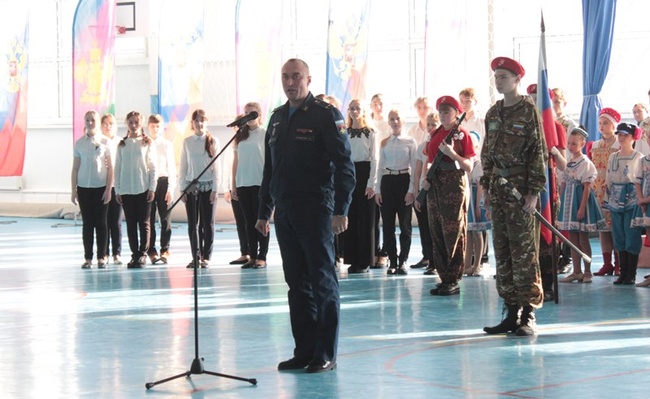 Sergii Atroshchenko. Photo from the network
Sergii Atroshchenko. Photo from the network
There are reports from 2020 of a celebratory concert for the Russian Defender of the Fatherland Day. During the celebration, besides Atroshchenko, the military Unit 75387 was represented by the deputy commander of the aviation squadron, Dmytro Gavrylkin, and the head of the aircraft and engine maintenance group, Andrey Maidenko. They may also have been involved in the shelling of Ukraine. Unfortunately, it was not possible to find their photos.
The Primorsko-Akhtarsk airfield is in the spotlight for the Ukrainian defenders. In July of this year, there were reports of powerful explosions in the airfield. Hopefully, this is not the last attack on a Russian military airfield.
Military base "Crimea"
After the annexation of Crimea, Russia turned the entire peninsula into a military base. They use it to launch missiles and Shahed drones, targeting Ukrainian cities.
The CPI has already found out that Cape Chauda near Feodosia is currently at the disposal of the Russian State Flight Test Centre, Named after Chkalov. It is a Crimea-based military unit 38651. Russia’s most significant centre is located in Aktiubinsk, Astrakhan region, and has a number of branches across the RF. The Centre is headed by Major General Radyk Bariyev.
He was also born in the Zhytomyr region and even served in the Ivano-Frankivsk region. Bariyev has been heading the unit since 2009.
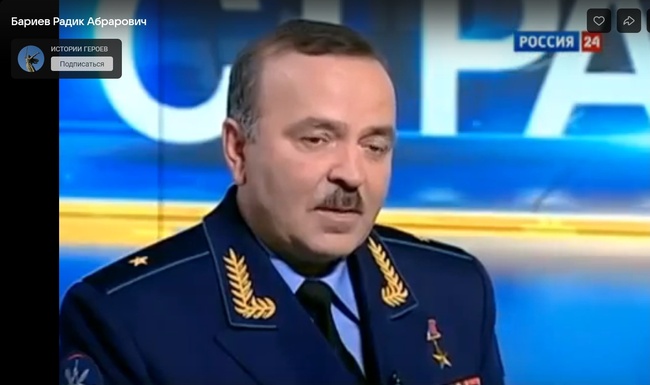 Radyk Bariyev. Screenshot from the video
Radyk Bariyev. Screenshot from the video
Several years ago, in an interview with a propaganda channel, Bariyev said that the Centre tests and certifies all equipment for the Russian Armed Forces. It is logical that the Iranian "Shaheds" ended up in the hands of the centre's specialists. Despite his active participation in the war against Ukraine, Radyk Bariyev is still not under sanctions, although the center he manages has been sanctioned by several countries.
In December 2022, several centre employees were secretly awarded the title of Heroes of the Russian Federation, including Sergii Demyanenko and Maksym Stefanov.
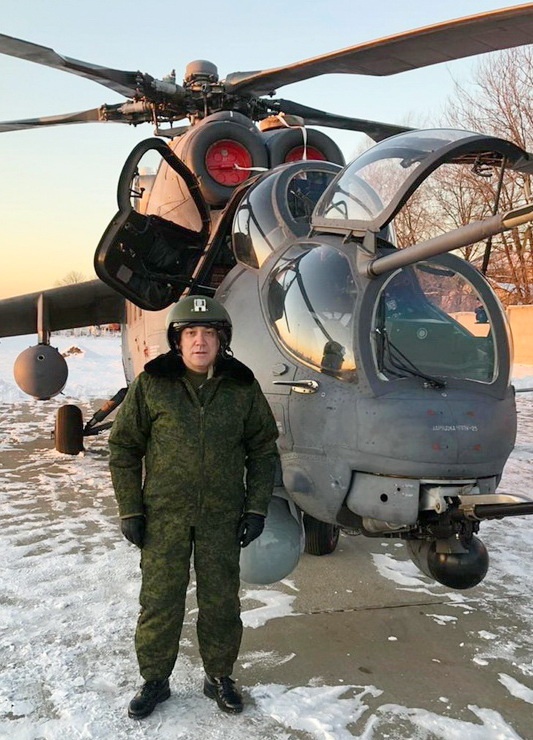 Sergiy Demyanenko. Photo from the network
Sergiy Demyanenko. Photo from the network
These people are obviously taking part in the war against Ukraine. By the way, Stefanov was personally decorated by the Russian Federation President, Putin. Our defenders were said to hit the plane on which he bombed Ukraine with an anti-aircraft missile. However, Stefanov survived. This became the reason for awarding him.
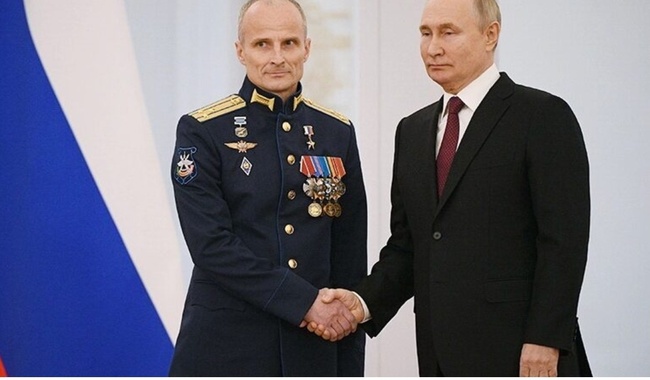 Maxim Stefanov (left) and Vladimir Putin. Photo from the network
Maxim Stefanov (left) and Vladimir Putin. Photo from the network
At the same time, Cape Chauda has already enjoyed Ukrainian "bavovna" (explosion). On July 19, a powerful explosion and detonation at a training ground in Crimea was reported. The invaders even had to evacuate local residents and block the highway nearby. The occupation authorities, as usual, did not officially recognise the loss.
They do not want to communicate
There is very little information about those involved in the "Shahed" shelling attacks on Ukraine. Nevertheless, in the Vkontakte network, we found a woman whose son served in Chauda during the so-called "Special military operation".
Evgenia Malykhina complains to the occupying authorities of Crimea that once her son's tour was over, he was not released but sent to the so-called DPR (Donetsk People’s Republic). Malykhina claims that they provide low-quality training to the military personnel and do not pay what was promised.
We wrote to Yevgenia Malykhina in Vkontakte. She read the message and later blocked the option of sending her messages.
Since the withdrawal of the Russian Federation from the Grain Deal, Ukraine has significantly improved its position on the Black Sea. So far, our military has destroyed several Russian warships, including a submarine. Ukrainian defenders also destroyed the headquarters of the Russian Black Sea Fleet in Sevastopol.
As a result, Ukraine arranged a temporary corridor in the Black Sea for the export of various goods. Dozens of ships have already used it, and their number is growing. Therefore, Russia's participation in the Grain Deal seems irrelevant now.
At the same time, Ukraine is facing new challenges. Most likely, in the winter period, Russia will switch from shelling grain silos to energy infrastructure as it was the case last year.
Олена Чернишова











